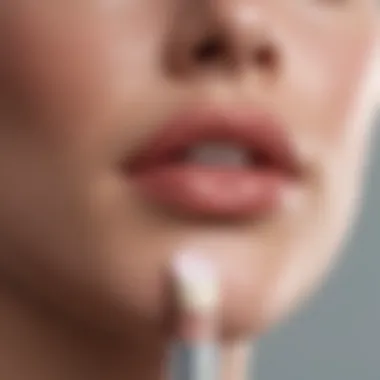Best Lip Balm for Hydration: A Comprehensive Guide


Intro
Choosing the right lip balm is essential for maintaining hydrated and healthy lips. Many people underestimate the importance of hydration in lip care. A quality lip balm not only offers immediate relief but also contributes to long-term lip health. In this guide, we will explore various formulations, key active ingredients, and the standout products on the market designed specifically for hydration.
Throughout this article, readers will gain insights into the unique properties of different lip balms, their benefits and drawbacks, and practical advice to incorporate hydration into their daily lip care routines. Understanding these elements helps ensure that everyone makes informed decisions tailored to their specific needs.
Hydrated lips are vital to a person's overall beauty regime. We will delve into the effects of climatic conditions on lip moisture levels and the role of ingredients like shea butter, coconut oil, and beeswax. These components play a significant part in nourishing and protecting lips from the elements.
This guide is not just for those struggling with dry or chapped lips; it is beneficial for anyone interested in enhancing their lip care routine and maintaining a healthy appearance. Let’s begin with a discussion on the various lip balm options available on the market.
Understanding Lip Hydration
Lip hydration plays a crucial role in maintaining the overall health of your lips. This section explores the various aspects of lip hydration, why it matters, and the implications of neglecting it.
The Importance of Hydrated Lips
Hydrated lips are essential not just for aesthetics but also for health. Well-moisturized lips enhance comfort, allowing natural lip movement without pain or irritation. Dehydration leads to undesirable effects, such as chapping and cracking, which can be both unsightly and uncomfortable. Moreover, hydration contributes to skin elasticity, preventing premature aging. The skin on the lips is thinner than that on other parts of the body, making them more susceptible to environmental factors. Therefore, maintaining hydration is vital. It protects the lips from UV damage, a often overlooked consequence of dryness. A constant routine of moisturizing can create a barrier against external aggressors.
Common Lip Problems Caused by Dehydration
Dehydration can manifest in several noticeable lip issues, each with unique characteristics.
Chapping
Chapped lips is a common problem affecting many people. It occurs when moisture is lost, leading to dry, flaky skin. Chapping is usually characterized by rough texture and sometimes redness. It can feel painful, especially during colder months. When lips become dry, they are more prone to irritation and may also bleed in severe cases. Chapping impacts overall comfort, making it difficult to speak or eat without discomfort. Addressing chapped lips quickly is essential, as it can lead to further complications.
Cracking
Cracked lips can be even more painful than chapped ones. This condition may occur as a result of extreme dehydration, typically associated with environmental factors or excessive lip licking. The cracks can be deep and often create a sense of urgency to address them. Cracked lips may become inflamed, leading to infection, which compels individuals to seek immediate solutions. This condition can affect daily activities, as opening the mouth widely might cause pain. Individuals often notice that cracked areas are sensitive to temperature changes, making it essential to understand the need for regular moisture.
Discoloration
Discoloration of the lips is another sign of dehydration. When lips lack moisture, they can appear dull or uneven in color. This change can affect one’s confidence and overall appearance. Discoloration might be mistaken for other dermatological issues if not recognized as dehydration. It signifies an underlying issue that requires attention. Maintaining hydration can help restore the natural color of the lips. Some individuals may seek products that promise to brighten their lip tone, but addressing the dehydration source is the foundational approach.
In summary, understanding lip hydration is integral to maintaining healthy and attractive lips. Recognizing the signs and consequences of dehydration is the first step towards effective treatment and prevention.
Key Ingredients in Lip Balm
Choosing the right lip balm involves understanding its key ingredients. The composition of these products greatly influences their effectiveness in providing hydration and protection. Each ingredient serves a specific purpose, contributing to the overall ability of the balm to nourish lips and combat dryness. In this section, we explore important categories of ingredients commonly found in lip balms, their benefits, and considerations for selection.
Natural Oils and Butters
Natural oils and butters are fundamental components in most hydrating lip balms. They serve as emollients, creating a barrier that locks in moisture and softens the lips. Let’s delve into some of the most popular oils and butters.
Shea Butter
Shea butter is renowned for its excellent moisturizing properties. Extracted from the seeds of the shea tree, its rich buttery texture makes it a popular choice. Shea butter is highly beneficial because it contains vitamins A, E, and F. These vitamins help in repairing and nourishing dry lips. The unique fatty acid profile provides deep hydration while also protecting the skin from environmental damage. While shea butter is generally well tolerated, some people may experience allergic reactions, so it is important to test the product initially.
Coconut Oil
Coconut oil is another favorite ingredient in lip balms. It possesses strong antibacterial and antifungal properties, offering additional skin protection. Its light, non-greasy texture allows for easy application without feeling heavy on the lips. Coconut oil effectively locks in moisture, leaving lips soft and smooth. It is naturally derived and appeals to many who prefer organic products. However, it can solidify in colder temperatures, possibly affecting the texture of the balm.
Avocado Oil
Avocado oil stands out due to its ability to penetrate deeply into the skin layers. Rich in oleic acid and other healthy fats, it promotes healing and reduces inflammation. The presence of vitamins A, D, and E enhances its reputation as a premium lip balm ingredient. This oil is especially beneficial for those with sensitive or cracked lips, providing both hydration and nutrient replenishment. However, its thicker consistency may not be suitable for everyone, particularly those who prefer lighter formulations.
Humectants for Moisture Retention
Humectants are essential in lip balms as they attract moisture from the environment into the skin. Their role in hydration cannot be understated. Let's explore two prominent humectants.
Glycerin


Glycerin is a common humectant found in many skincare products. In lip balm, it works by drawing moisture to the lips, keeping them hydrated. It is colorless, odorless, and well tolerated by most skin types. Glycerin's ability to maintain moisture increases the effectiveness of lip balms significantly. It is generally safe for use, but in extremely dry conditions, it may pull moisture away if there is not enough humidity in the environment.
Hyaluronic Acid
Hyaluronic acid is known for its incredible capacity to hold moisture—up to 1,000 times its weight in water. This characteristic makes it a premium ingredient in hydration-focused products. In lip balms, hyaluronic acid provides intense hydration, making lips appear plump and healthy. It works well for almost all skin types, though it may interact with other ingredients, so formulations should be considered carefully.
Additional Soothing Agents
In addition to hydrating ingredients, many lip balms include soothing agents for enhanced comfort. These ingredients help calm irritation and promote healing, benefiting lip health in various ways.
Aloe Vera
Aloe vera is well known for its soothing properties. It can relieve dry, chapped lips, making it an excellent addition to hydrating balms. Its anti-inflammatory qualities help to reduce redness and irritation, which is particularly useful for sensitive skin. Aloe vera is also packed with vitamins and topically applied enzymes that promote healing. Though largely beneficial, the efficacy may vary depending on the formulation and concentration.
Vitamin E
Vitamin E is a powerful antioxidant, making it a common ingredient in lip balms. It helps protect lips from environmental damage and supports skin repair. Its moisturizing properties prevent dryness and keep lips smooth. While it suits many people, those with very oily skin might find it too rich, leading to possible breakouts when applied.
Understanding these key ingredients can aid when selecting a lip balm that truly meets hydration needs.
Types of Lip Balms
Understanding the types of lip balms is essential for anyone looking to maintain lip hydration effectively. Each type of balm comes with its unique features, user experience, and appropriateness for different situations or skin types. Recognizing these differences can guide consumers in selecting the most suitable product, ultimately leading to healthier and more hydrated lips.
Stick Balms
Pros and Cons
Stick balms are perhaps the most common form of lip product. They offer a convenient, mess-free application. Their solid form makes them easy to carry, and they generally last longer than other types due to their thicker consistency. However, one major disadvantage is that they might not always provide the immediate moisture that some users desire. Stick balms can sometimes feel waxy, which may not give the sensation of hydration that many people expect.
The primary characteristic of stick balms is their ease of use. Most users appreciate the straightforward method of application. Still, one must consider that some might find them heavy or thick. Stick balms can often provide a protective barrier but may lack the deep moisture that other formulas deliver effectively.
Best Brands
For quality stick balms, brands like Burt's Bees, ChapStick, and Nivea often come to mind. Burt's Bees is recognized for using natural ingredients, which gives consumers peace of mind. ChapStick, a staple brand, offers a variety of flavors and formulations suitable for different contexts. Nivea varieties are known for enriching hydration too. Users often favor these brands due to their longstanding reputation and effective formulations.
Tube Balms
Pros and Cons
Tube balms offer a different experience than stick forms. They usually have a softer and often creamier texture. This can result in easier application for many people. However, a common drawback is their potential for messiness. When not contained, tube balms can lead to excess product application or leakage, especially in bags or pockets.
The main advantage is that tube balms provide a more liquid or creamy formulation. This can be particularly soothing for severely chapped lips. However, users might feel that they need to reapply more often, leading to quicker depletion of the product.
Best Brands
Some prominent tube balm brands include Aquaphor, Alba Botanica, and Vaseline. Aquaphor is well-known for its multi-purpose applications and strong moisture retention. Alba Botanica focuses on natural ingredients, appealing to those seeking organic options. Vaseline, recognized worldwide, also serves as a versatile option for dry skin. These brands stand out for their effectiveness and accessibility.
Lip Butter and Creams
Pros and Cons
Lip butters and creams tend to provide the richest hydration among lip products. They are often thicker in texture and designed specifically for intense moisture restoration. However, the thicker consistency can make them feel heavy or greasy. Some users may find them excessive for daily or casual use.
The significant benefit of lip butters or creams is their intense hydration. They often contain natural oils and butter that nourish and replenish the lips effectively. Though the richer texture can be slightly uncomfortable for some, the trade-off is often well worth it for those facing chronic dryness.
Best Brands
When it comes to lip butters and creams, products from brands like Fresh, L’Occitane, and Kiehl's are often recommended. Fresh's Sugar Lip Treatment provides both hydration and a hint of color. L’Occitane's Shea Butter Lip Balm is known for its soothing properties. Kiehl's offers a whipped formulation that melts into the lips, providing lasting moisture. These brands are popular for their combination of effective ingredients and luxurious textures.
Criteria for Selecting the Best Lip Balm
When it comes to maintaining hydrated lips, the choice of lip balm is crucial. The effectiveness of a lip balm can vary greatly depending on several criterea. Understanding these factors can help consumers make informed decisions that cater to their specific needs. This section discusses the importance of skin type, environmental factors, and ingredient sensitivities when selecting the best lip balm for hydration.


Skin Type Consideration
Sensitive Skin
Sensitive skin often reacts negatively to harsh ingredients found in many lip balms. This skin type requires careful selection of products that are free from irritants. Lip balms designed for sensitive skin typically include minimal and gentle ingredients. They provide a protective layer without causing discomfort or reaction. Non-fragrance options are particularly popular, making them a beneficial choice in this article.
Dry Skin
Dry skin needs extra moisture and protection. Lip balms formulated for this type usually contain added emollients that seal in moisture. These products can include richer ingredients like shea butter or lanolin, allowing for greater hydration. Choosing a balm tailored for dry skin can significantly improve comfort and appearance, making it a popular consideration in this guide.
Oily Skin
Oily skin may require lighter formulations since heavy balms can clog pores. However, it is still essential to hydrate, which means a balance is needed. Products that contain ingredients like jojoba oil might be suitable, as they provide moisture without leaving a greasy feel. Understanding oily skin characteristics can guide users in selecting effective products, making it a valuable aspect of this article.
Environmental Factors
Climate Conditions
Climate can significantly affect lip hydration. In dry or windy environments, lips may lose moisture more rapidly. Choosing a lip balm that offers substantial protection against the elements becomes vital in such conditions. Balms with SPF are useful in sunny regions, providing necessary defense. Understanding this factor can help users choose a product that suits their environmental needs effectively.
Seasonal Variations
Lip care does not remain constant throughout the year. Seasonal changes can alter how lips react, especially in colder months when moisture levels drop. Lip balms formulated to combat dry, cracked lips become essential during the winter. On the other hand, lighter formulations may be more suitable in warmer months. Recognizing how seasons impact lip health is important when selecting an appropriate balm.
Ingredient Sensitivities
Allergies
For individuals with allergies, ingredient lists must be examined closely. Some common lip balm ingredients can trigger reactions in sensitive users. Identifying preferred allergens enables consumers to avoid problematic products. This consideration is essential for ensuring safety alongside hydration in lip care.
Preference for Organic Products
Many consumers are inclined towards organic products due to their perceived safety and environmental impact. Organic lip balms often use naturally derived ingredients that are less likely to irritate the skin. However, it is essential to ensure that these formulations also provide sufficient hydration. Balms marketed as organic can offer peace of mind but should still deliver on efficacy.
"Choosing the right lip balm is more than just a preference; it's about understanding your unique skin needs and environmental influences."
Top Recommendations for Hydrating Lip Balms
Choosing the right lip balm can significantly impact lip health and hydration. With a multitude of options available in the market, knowing the top recommendations helps in making informed choices. These products vary in formulations, effectiveness, and user experiences.
High-performing commercial brands often set the standard in the industry. While several emerging brands offer new and innovative approaches, established names carry trust based on their long-standing reputation. Understanding the features, benefits, and potential drawbacks of these brands will guide users toward the best options for their needs.
High-Performing Commercial Brands
Brand A
Brand A is well-known for its deep moisturizing properties. It contains a unique blend of natural oils that provide a protective barrier against environmental factors. Its key characteristic is a formula that combines hydrating ingredients like shea butter and coconut oil. This makes it a popular choice for those seeking intense hydration.
The unique feature of Brand A is its long-lasting effect. Users often note that they need to apply it less frequently compared to other products. However, some might find the texture a bit thick, which may not suit everyone's preference.
Brand B
Brand B has gained recognition for its lightweight feel and fast absorption. It is designed with active ingredients that not only hydrate but also nourish the lips. A significant characteristic of Brand B is the inclusion of hyaluronic acid, known for its moisture-retaining properties, making it a beneficial choice for daily hydration.
One of its unique features is the variety of flavors and scents available, which enhance the user experience. Nonetheless, some users might prefer a more traditional, scent-free option, which could be seen as a minor disadvantage.
Brand
Brand C is noted for its eco-friendly approach, using sustainable and organic ingredients. This brand appeals to environmentally conscious consumers looking for effective lip care without compromising on their principles. The standout aspect of Brand C is its emphasis on natural components, which is a big draw for many.
Although its efficacy is highly regarded, some users may find it less moisturizing than other commercial options, especially in extreme weather conditions. This could be a consideration for those living in harsher climates.


Emerging Brands to Consider
New Brand
New Brand D has entered the market with a focus on innovative formulations that cater to specific lip concerns. The key characteristic of this brand is the integration of botanical extracts that claim to enhance lip health naturally. Consumers have found this approach refreshing and appealing.
A notable advantage is its commitment to cruelty-free products, attracting ethically minded consumers. However, since it is a newer brand, some users might feel uncertain about its long-term results compared to established brands.
New Brand E
New Brand E focuses on targeted solutions for lip care, offering products designed specifically for sensitive lips. The emphasis on hypoallergenic ingredients is a significant characteristic, making it a recommended choice for those prone to irritation.
The unique selling proposition of New Brand E lies in its gentle formulation combined with effective hydration. However, the price point may be higher than traditional lip balms, which might deter budget-conscious buyers.
"Choosing the right lip balm is essential for achieving optimal hydration and ensuring lip health throughout the year."
Overall, understanding these top recommendations allows for informed decision-making. From trusted commercial brands to innovative new entries, each offers unique benefits and considerations tailored to varying needs.
Application Tips for Effective Hydration
Applying lip balm correctly is crucial for achieving optimal hydration. Proper application ensures that active ingredients penetrate effectively, providing immediate moisture relief and long-lasting benefits for your lips. Hydration does not occur solely from the lip balm itself; it is also about how you apply and maintain the balm.
How to Apply Lip Balm Properly
To achieve the best results from your chosen lip balm, here are some essential steps to follow:
- Start with Clean Lips: Before application, make sure your lips are free from any makeup or residue. Use a gentle lip scrub or a soft cloth to exfoliate if necessary.
- Use the Right Amount: Apply a thin layer of lip balm. A small amount should suffice, as too much may lead to a sticky feeling.
- Even Coverage: Spread the balm evenly across your lips. Use your finger or the applicator to ensure that every area is covered. Don't forget the corners.
- Avoid Overlapping: Do not apply too frequently in short intervals. Instead, wait a moment for the balm to absorb before reapplying.
- Incorporate Nightly Care: Using a thicker formula or a sleep mask before bed can provide additional hydration while you sleep.
Adhering to these simple strategies can significantly enhance lip hydration, which is fundamentally important, especially in arid environments.
Frequency of Application
The frequency of lip balm application greatly influences the overall health of your lips. Here are some important aspects to consider:
- Use Throughout the Day: Regular touch-ups, particularly after eating or drinking, help maintain a protective barrier.
- Adjust Based on Weather: In harsh weather conditions, you may need to apply more frequently. During winter, for example, the cold can quickly dry out your skin.
- Listen to Your Lips: If you begin to feel dryness or discomfort, it's time to reapply, regardless of the clock.
- Avoid Habitual Excess Use: It may be tempting to apply frequently, but overuse can lead to dependency and hinder your lips' natural moisture retention.
A note of caution: Overuse of lip balm can sometimes create a cycle where your lips become reliant on the product, leading to dryness when not applied.
Understanding these application tips and recognizing the appropriate frequency can lead to healthier, better-hydrated lips. By being mindful about how and when you apply lip balm, you can maximize hydration benefits effectively.
Maintaining Healthy Lips Beyond Balm
Maintaining healthy lips extends beyond the application of lip balm. Hydration and proper care play crucial roles in achieving soft and supple lips, especially in environments that can cause dryness and irritation. Lip balms are effective, but they are only part of a comprehensive care routine. This section explores essential strategies to keep lips healthy and hydrated.
Hydration from Within
Importance of Water Intake
Staying hydrated is vital for overall health and has a direct impact on lip health. When the body lacks adequate fluids, lips can become dry and cracked. Drinking sufficient water daily is fundamental for maintaining moisture balance. A common guideline is to aim for at least eight 8-ounce glasses of water per day, but individual needs may vary based on factors like activity level, climate, and personal health.
When you commit to consistent water intake, you promote circulation and support cellular function, which are essential for skin integrity. Notably, the skin on the lips is thinner than on other parts of the body, making it more susceptible to dehydration. Therefore, prioritizing water consumption becomes a beneficial choice for individuals aiming to improve their lip health.
Monitoring Diet for Lip Health
Nutrients Beneficial for Lips
A well-balanced diet contributes significantly to lip health. Certain nutrients, such as vitamins A, C, and E, along with omega-3 fatty acids, are particularly effective in maintaining skin health. Foods rich in these nutrients help for cell regeneration and protect against free radicals, which can damage skin cells. Incorporating items like avocados, nuts, berries, and green vegetables can enhance the body's natural buffering against lip dryness.
By recognizing the role of nutrition, individuals can make choices that support their lip health. When well-nourished, lips are less likely to succumb to issues like dryness or chapping.
Avoiding Irritants
Irritants can detrimentally affect lip health and should be avoided. Harsh ingredients found in some cosmetics or skincare products may lead to irritation or allergic reactions. Additionally, weather conditions such as wind, sun exposure, and temperature extremes also act as irritants, stripping away natural moisture from lips.
Identifying and eliminating these irritants is crucial. For example, opting for fragrance-free or hypoallergenic products can help minimize reactions. Maintaining a stable lip-care routine that includes protective balms can alleviate the effects of irritants on the skin.
"Healthy lips come from not just external care but also from internal hydration and nutrition."
In essence, the pursuit of hydrating lips should integrate both topical application and lifestyle choices. By understanding and implementing these methods, individuals can achieve and maintain optimal lip health, moving beyond reliance on just lip balm.



